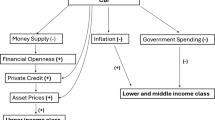Abstract
This paper examines how “lumping”, the aggregation of different states of a Markov chain into one state, affects the underlying properties of the Markov process. Specifically, a Markov chain model of income convergence for US states is estimated, and different quantile lumpings are tested to determine if they preserve the Markov property. This work ties into the broader literature on modelling regional income convergence using Markov processes, specifically with attempts to quanity how reasonable choices about state space compression are and the quantification of these choices’ consequences. First, we estimate a rank Markov model. From this, we find that Markov models for regional income convergence lose the Markov property when quantile lumps are large and contain many states, but perform well when lumps get smaller, containing fewer states. This new positive finding and technical work paves the way for broader studies of lumpability of discrete Markov models for geographic or policy regions.


Similar content being viewed by others
References
Agresti, A.: Categorical Data Analysis. Wiley, Berlin (2013)
Anderson, T.W., Goodman, L.A.: Statistical inference about Markov chains. Ann. Math. Stat. 28, 89–110 (1957). (01413)
Buchholz, P.: Exact and ordinary lumpability in finite Markov chains. J. Appl. Probab. 31, 59–75 (1994)
Bulli, S.: Distribution dynamics and cross-country convergence: a new approach. Scott. J. Polit. Econ. 48(2), 226–243 (2001). (00124)
Fingleton, B.: Estimates of time to economic convergence: an analysis of regions of the European Union. Int. Reg. Sci. Rev. 22(1), 5–34 (1999)
Fingleton, B.: Independence, stationarity, categorical spatial data and the chi-squared test. Environ. Plan. A 15(4), 483–499 (1983)
Fingleton, B.: Analyzing cross-classified data with inherent spatial dependence. Geogr. Anal. 18(1), 48–61 (1986)
Guihenneuc-Jouyaux, C., Robert, C.P.: Discretization of continuous Markov chains and Markov chain Monte Carlo convergence assessment. J. Am. Stat. Assoc. 93(443), 1055–1067 (1998). (00020)
Janssen, J., Manca, R.: Applied Semi-Markov Processes. Springer, Boston (2006). (00151)
Jernigan, R., Baran, R.: Testing lumpability in Markov chains. Stat. Probab. Lett. 64, 17–23 (2003). (00011)
Le Gallo, J.: Space-time analysis of GDP disparities among European regions: a Markov chains approach. Int. Reg. Sci. Rev. 27(2), 138–163 (2004). (00205)
Ledoux, J.: On weak lumpability of denumerable Markov chains. Stat. Probab. Lett. 25(4), 329–339 (1995)
Magrini, S.: The evolution of income disparities among the regions of the European Union. Reg. Sci. Urban Econ. 29(2), 257–281 (1999). (00302)
Pu, Y., Ma, R., Ge, Y., Huang, X.: Spatial-temporal dynamics of regional convergence at county level in Jiangsu. Chin. Geogr. Sci. 15(2), 113–119 (2005)
Quah, D.: Empirical cross-section dynamics in economic growth. Eur. Econ. Rev. 37(2), 426–434 (1993)
Quah, D.: Empirics for economic growth and convergence. Eur. Econ Rev. 40(6), 1353–1375 (1996). (01472)
Quah, D.T.: Empirics for growth and distribution: stratification, polarization, and convergence clubs. J. Econ. Growth 2(1), 27–59 (1997). (01389)
Rey, S.: Rank-based Markov chains for regional income distribution dynamics. J. Geogr. Syst. 16(2), 115–137 (2014)
Rey, S.J., Anselin, L.: PySAL: a python library of spatial analytical methods. In: Fischer, M.M., Getis, A. (eds.) Handbook of Applied Spatial Analysis, pp. 175–193. Springer, Berlin (2010)
Rey, S.J., Montouri, B.D.: U.S. regional income convergence: a spatial econometric perspective. Reg. Stud. 33(2), 145–156 (1999)
Rubino, G., Sericola, B.: On weak lumpability in Markov chains. J. Appl. Probab. 26, 446–457 (1989)
Rubino, G., Sericola, B.: A finite characterization of weak lumpable Markov processes. Part i: the discrete time case. Stoch. Process. Appl. 38(2), 195–204 (1991)
Sericola, B.: Markov Chains: Theory, Algorithms and Applications. Wiley, London (2013)
Author information
Authors and Affiliations
Corresponding author
Rights and permissions
About this article
Cite this article
Wolf, L.J., Rey, S. On the lumpability of regional income convergence. Lett Spat Resour Sci 9, 265–275 (2016). https://doi.org/10.1007/s12076-015-0156-0
Received:
Accepted:
Published:
Issue Date:
DOI: https://doi.org/10.1007/s12076-015-0156-0




